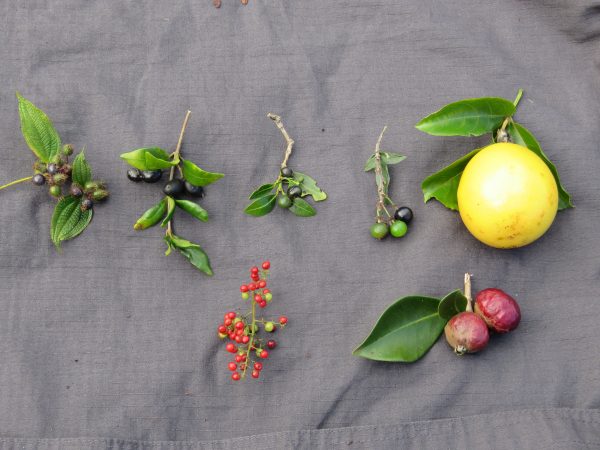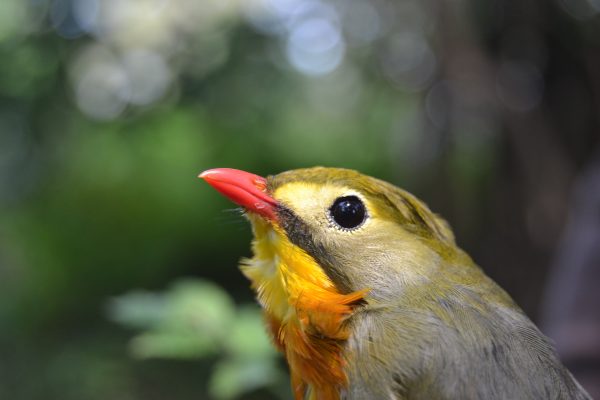April 4, 2019
On the Hawaiian island of Oahu, it is possible to stand in a lush tropical forest that doesn’t contain a single native plant. The birds that once dispersed native seeds are entirely gone, leaving a brand-new ecological community composed largely of introduced plants and birds. In a first-of-its-kind study published in Science, researchers demonstrate that these novel communities are organized in much the same way as native communities worldwide.
The discovery comes after an exhaustive examination of bird diets across Oahu and a subsequent network analysis describing bird-plant interactions on the island. Jeffrey Foster, associate professor in Northern Arizona University’s Department of Biological Sciences and the Pathogen & Microbiome Institute, was the principal investigator on the project. He worked with a team to examine the fecal matter of several thousand birds in order to determine what fruits they were eating and more importantly, whether those fruit seeds came from native or invasive plant species.

“We sorted 3,278 avian fecal samples, found 109,424 viable seeds from 21 different bird species and were able to determine the seeds came from 44 plant species, 15 of which were native,” Foster said.
Results showed introduced birds have developed complex patterns of interactions with plants, most of them non-native to the island. And when bird-plant interactions on Oahu were compared to native-dominated ecosystems around the world, they were strikingly similar.
The researchers also tested the stability of these bird-plant interactions by simulating the extinction of plant species. How fast would birds go extinct if plants in a given sequence were to be removed?
In previous research, Foster found that introduced birds are essential for the future of native forests in Hawaii. Most fruiting plants on the islands have evolved fruits to be dispersed by birds, but because nearly all of the native fruit-eating birds are extinct, native plants are dependent on introduced birds to spread their seeds to new sites.
“The rates at which Oahu communities collapsed in the simulations were very similar to native communities,” said Jeferson Vizentin-Bugoni, lead author on the study and postdoctoral researcher at the University of Illinois. “This means that now these novel networks in Hawaii are as stable as native-dominated communities.”

Although the results could be interpreted as a silver lining to the ever-increasing threat of invasive species and extinctions, the study showed introduced birds are predominantly eating and spreading invasive plants around the island, compounding an already hard-to-solve problem.
“We were able to determine that introduced species quickly become integrated into communities, providing a crucial ecosystem service, although not perfectly replacing native species,” Vizentin-Bugoni said. “Our research results indicate that introduced birds play a ‘double-edged sword’ role for conservation: they are the only dispersers of native plants; however, they disperse a much higher proportion of seeds from invasive plants.”
Although the novel community might have some of the same properties as a native ecosystem, the researchers stress it is not the same. The community is dramatically less diverse—study results indicate just four bird species are responsible for moving the bulk of the plants around the island.
“Birds and plants have been brought to Hawaii from numerous places worldwide, such as a songbird from China and a shrub from Central America, and have been invading native forests for more than a century. Thus, few of the birds and plants have ever seen each other in their evolutionary history. Yet, when you look at their interactions they seem like old friends who have known each other forever,” Foster said.
Before Hawaii became the extinction and invasive species capital of the world, it had developed rich and unique ecological communities over millions of years. Experts estimate that in the last 700 years, 77 species and subspecies of birds in the Hawaiian Archipelago have gone extinct, accounting for 15 percent of bird extinctions worldwide.
“Because Hawaii is so isolated, there were endemic species you could only find there,” Vizentin-Bugoni said. “Once they’re gone, they’re gone. And we not only lose biodiversity but also the potential of those species benefitting humans.”

Co-authors on the article, “Structure, spatial dynamics, and stability of novel seed dispersal mutualistic networks in Hawai‘i,” include Corey Tarwater, Donald Drake, Jason Gleditsch, Amy Hruska, Patrick Kelley and Jinelle Sperry. The work was supported by Northern Arizona University, the U.S. Department of Defense, the University of Wyoming, University of New Hampshire, University of Hawai‘i and the U.S. Army Engineer Research and Development Center (ERDC) EQI Basic Research Program.
Carly Banks | NAU Communications
(928) 523-5582 | carly.banks@nau.edu




